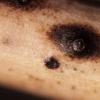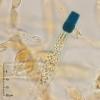
30-03-2015 14:15
Hi to all This Anthostomella grew on wet dead ste

01-04-2015 18:09
 Bernard CLESSE
Bernard CLESSE
Une espèce commune (si je l'ai bien reconnue !) m

31-03-2015 22:24
 Bernard CLESSE
Bernard CLESSE
Sur tiges pourries d'ortie (Urtica dioica). Une ba

01-04-2015 12:29
 Cacialli Gabriele
Cacialli Gabriele
Bonjours aux amis...Je essaie de reconstituer l'hi

01-04-2015 11:40
Cvenkel MiranSlovenia, stone, karst area.The fruiting body mark

31-03-2015 19:11
 Dartanha Soares
Dartanha Soares
Hi all,Can someone provide me a pdf copy of the fo

31-03-2015 21:20
 Bernard CLESSE
Bernard CLESSE
Sur tronc mort et décortiqué de feuillu, charm
Hi to all
This Anthostomella grew on wet dead stems of Ammophila arenaria. The fungus makes clypeate single blackish perithecia with papilate ostioles. Asci with a massive IKI positive apical apparatus longer than broad. Ascospores broadly inequilateral with spiral germ slit and peculiar partial gel sheaths at the poles. I think don't fits with A. spiralis or A. umbrinella.
Some idea for help me?
Thanks again

This could be Anthostomella lugubris, a species we find on Ammophila in our country.
Bernard
Hi friends,
Again an amazing record of Enrique !
Clearly it isn't A.lugubris.
Closer than this last one is A. umbrinella, you saw it, but host and macroscopy don't fit. Thus appendages are lacking. Exit this hypothesis.
You can find it in Rappaz (into the genus Leptomassaria). Both species, L.simplex andL. unedo, are corticolous.
A. francisiae has such apical appendages, but the germslit is straight. Exit again.
My conclusion is that your Anthostomella is perhaps new.
Alain
I think so
Thanks again, Alain







